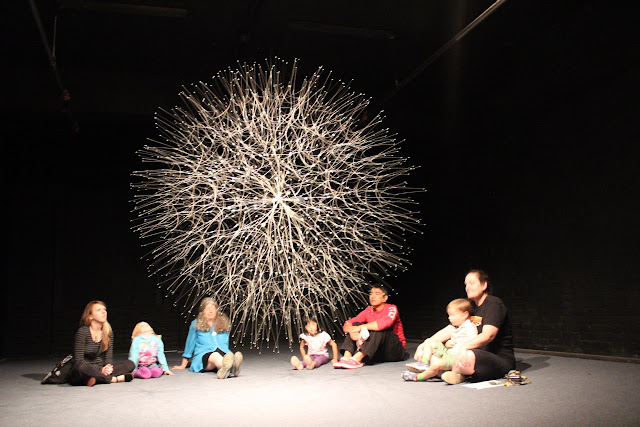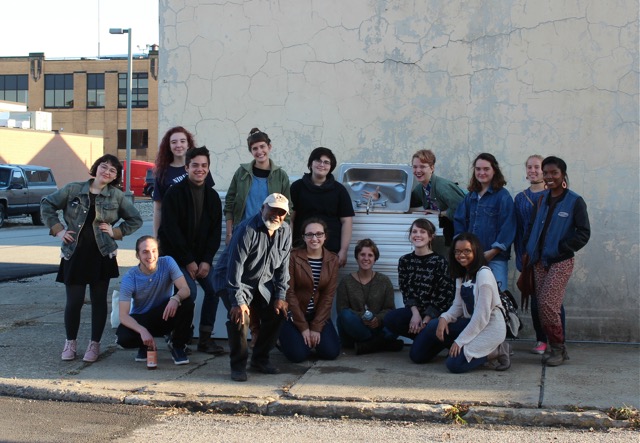Factory Installed @ 500 Sampsonia Way has opened. We have brand new artist interviews with exhibiting artists
Rob Voerman,
Bill Smith,
Lisa Sigal and
Marnie Weber!
The
Mattress Factory Soundcloud page now hosts 34 different audio guides that cover most of our permanent exhibitions, commentary on the museum's history, mission and programming, and artist interviews for the
Factory Installed exhibition currently on view at our 1414 Monterey and 500 Sampsonia Way galleries. Here are some highlights of the conversations with exhibiting artists.

"...It is a work based on one of the famous landmarks here in Pittsburgh, the Cathedral of Learning. I was fascinated when I saw it on the internet, that someone initiated such an ambitious project just for functioning of learning and study. So I thought that really fits with the way I work, some installations are really programmed to do workshops, lectures and so... and then I found out about the Nationality Rooms, and I thought let's take some, almost like a fragment of this building and make my own Nationality Room which is not actually a nationality but a bit undescribed. It is a space to reflect and to think also about where we are heading to, how do we engage to future problems, issues... and just also a place to enjoy."
"I started making installations 12 years ago or something and at first it was spaces you could just sit in and sometimes it became a bar. And in recent years I used them a bit more for engagement. I was always engaged in ecology and politics and all kids of aspects. I noticed that these installations that you can program them, make a side program in and around them based on the content of the works and the context, where the work is. I really like that I can actually use these installations in sometimes not only a safe environment in a museum but also in a public or semi-public space..."

"Well I built a structure that, you know, I just try to build things the way I think nature would build things. And it just happened that I built a round structure that uses materials very efficiently, and it just became a branching structure in 360 degrees... And later, after analyzing it, it's a network, cause everything is interconnected... After I built it, I did some research about networks, and it turns out that there's a lot of networks that... look very similar to the thing I built. Just recently, I got contacted by a network researcher that was putting a textbook together, and they wanted to use a picture of that, in front of a chapter that's related to spreading phenomenon, like the way disease spreads throughout a population... So that was kind of nice that somebody saw it online and recognized it as being representative of some kind of phenomenon like that."
"As far as people, I mean I think I have the best conversations with people off the street... Sometimes you'll get, maybe somebody from a university, that kind of 'poo-poos' it just because it's art, and then you get artists that look at it, and they don't know what's going on. So, I think that's probably the most important people to connect with anyway, is the people off the street, so I'm okay with that... I just got an idea and it's one that I can work with for a long time, so I'm just trying to do something practical... Art isn't just having fun, it's serious... and there's a need for creative people to solve problems, because there are a lot of problems... There's so much need for new ideas these days, and it's so fertile for that, I mean now's the time to do it."

"So when I was asked to do this show at the Mattress Factory I started to think about displacing the walls and lots of the vocabulary that I had been thinking about with imagery, because I have been exploring imagery as well. And using imagery of places that have... maybe this is another tangent to go off on... just thinking a lot about displacement and gentrification. I started to work on sheet rock, I started to paint and then, it's a love / hate relationship with that material, it falls apart, it crumbles, it's heavy, even though it claims not to be. So I decided that it would be interesting to hand-make something that is fabricated."
"It is actually especially poignant me speaking to you today because I realized this morning it's Septermber 11th, and not that my career as an artist began on September 11th, but somehow my thinking about making paintings shifted on that day. I had been installing for a month at a gallery in Chelsea... and so I guess during the course of that show I kept thinking about the ways in which we as artists bring our content to our work. Or bring expectation that there is meaning to what we do. When something as horrific as this day how many years ago in 2001, it emptied out the meaning. It was just like... whatever the wall surface, it's nothing. And there was something that of course a month later you're like, yeah, you're right, it does have meaning because this is what I do, this is my community and this is what I decided to do with my life, but it's also meaningless. What happened was I began to think about this tension of something both having meaning and not and seeing things and then they disappear. So that was my beginning with making installations and it came through painting..."

"The Mattress Factory was a unique situation because typically museums want to know everything you are going to do ahead of time. So this was a very fun project because I was able to see the space and then imagine what could be in it. The space looked like a tunnel to me so I thought it would be nice to put a giant child's model of a steam engine blown up as a ghost... when I was growing up I lived in Taiwan for a year and we had a steam engine track near our house... I would hear the sounds of the steam engine starting up around the time I was introduced to the concept of metaphor and I think it was the first time I really understood the metaphor of the train as it being a beast or a monster or alive, all the things that people attribute steam engine sounds to. So it seemed perfect. And I wanted it to be a ghost train because it is a nice metaphor for transforming into the non-material world."
"The masks are characters I get to know, that I feel I have a chemistry with. I have a huge collection and I reuse them and they go off onto different journeys of their own to different museums or galleries or situations, films... Once the whole body and the head are put together and completed, you feel like it could almost be like a totem, a wandering spirit inhabits the piece and is standing there. I have had some very strange uncanny moments in my studio with some of the completed characters. People have told me that in museums and galleries sometimes they feel like there is a presence in the figure and I would love that to be true... I would love to have a wandering spirit find a home and settle and enjoy the audience that comes through to see the piece."




















































